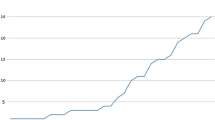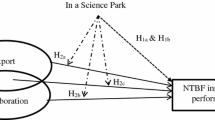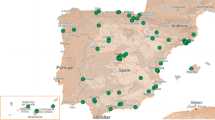Abstract
This paper investigates the impact of Science Parks on growth and innovativeness of affiliated firms. Both the role and the effectiveness of these policy instruments in sustaining tenants’ performances are still open issues. We rely on unique Italian data and compare the performance of firms located within a park with a control sample of off-park firms. Firstly, we focus on the estimation of the treatment effect of being located within the park. Our results show a significant difference between on and off park firms with respect to their innovativeness and propensity to invest in R&D; to the contrary, firms’ growth appears unaffected by location effects. Secondly, we analyse what features of Science Parks drive the impact on the diverse measures of performance. Our main finding is that both patenting activity and R&D investments are actively sustained by the presence and quantity of research centres within the park. Growth remains a largely unexplained phenomenon and Gibrat law is found to hold robustly within the class of on-park firms.






Similar content being viewed by others
Notes
IASP International Board, 6th February, 2002.
For an updated mapping of these structures an interesting resource is the website of the POLics project: http://www.polics.it/en.
A list of all parks belonging to such an association can be found here: http://www.apsti.it. The two excluded members are not parks but entities coordinating consortia of institutions including regional administration offices, the national research councils and, eventually, parks themselves.
Only partially completed questionnaires had been disregarded.
Notice that all firms in our dataset are Italian and we used the national ATECO classification which, at the 1-digit level, corresponds exactly to the NACE Rev.2.
This is the case of firm size and growth, in accordance with the literature, but also of innovation-related variables like patent applications and R&D growth.
It is measured as the shortest path in terms of kilometers along main infrastructures (roadways and railways) between the address of firms’ headquarters and that of the park the firm is affiliated to.
Note that we are removing big companies (above 900 employees) from our sample, thereby reducing the risk of including multinational firms.
Notice that industrial traditions and firms performances vary considerably passing from Northern to Southern Italian regions and that our sample is unevenly distributed both across regions and sectors.
The sole observation we were not able to match was unique in its category.
Identified at 2-digit NACE Rev. 2 level.
In this discussion we focus on sample averages for two reasons: they can be considered as summaries since results are unaffected in a year by year analysis and, secondly, these variables will be used in subsequent cross-section analysis due to the impossibility of building up a longitudinal dataset (see next sections for further explanations).
Not reported for sake of brevity. Normality is tested for all our variables, log-normality is tested for growth rates. In particular we used QQ-plots, Shapiro–Wilk and Jarque–Bera tests.
This evidence supports the idea that firms with closer ties to Universities achieve better performances; see for example Siegel and Wessner (2012) and references therein.
References
Aghion, P., & Howitt, P. (1992). A model of growth through creative destruction. Econometrica, 60(2), 323–351.
Audretsch, D., Bozeman, B., Combs, K., Feldman, M., Link, A., Siegel, D., et al. (2002). The economics of science and technology. The Journal of Technology Transfer, 27(2), 155–203.
Audretsch, D. B., Coad, A., & Segarra, A. (2014). Firm growth and innovation. Small Business Economics, 43(4), 743–749.
Battaglia, R., Lamperti, F., & Siligato, L. (2012). AREA SP: Potere alleccellenza. In: Dai distretti tecnologici ai polidi innovazione. Milan: Egea.
Bellavista, J., & Sanz, L. (2009). Science and technology parks: Habitats of innovation: Introduction to special section. Science and Public Policy, 36(7), 499–510.
Bianchini, S., Pellegrino, G., & Tamagni, F. (2014). Innovation strategies and firm growth: New longitudinal evidence from spanish firms. Technical report, Laboratory of Economics and Management (LEM), Sant’Anna School of Advanced Studies, Pisa, Italy.
Blackwell, M., Iacus, S. M., King, G., & Porro, G. (2009). Cem: Coarsened exact matching in stata. Stata Journal, 9(4), 524–546.
Bottazzi, G., & Secchi, A. (2006). Explaining the distribution of firm growth rates. RAND Journal of Economics, 37, 235–256.
Bound, J., Cummins, C., Griliches, Z., & Bronwyn, H. (1984). Who does R&D and who patents? In Z. Griliches (Ed.), R&D, patents, and productivity (pp. 21–54). Chicago: University of Chicago.
Brusoni, S., Cefis, E., & Orsenigo, L. (2006). Innovate or die? A critical review of the literature on innovation and performance. Technical Report 179, CESPRI—Università Commerciale Luigi Bocconi.
Coad, A., & Rao, R. (2008). Innovation and firm growth in high-tech sectors: A quantile regression approach. Research Policy, 37(4), 633–648.
Colombo, M. G., & Delmastro, M. (2002). How effective are technology incubators?: Evidence from italy. Research Policy, 31(7), 1103–1122.
Demirel, P., & Mazzucato, M. (2012). Innovation and firm growth: Is R&D worth it? Industry and Innovation, 19(1), 45–62.
Díez-Vial, I., & Fernández-Olmos, M. (2014). Knowledge spillovers in science and technology parks: How can firms benefit most? The Journal of Technology Transfer, 40(1), 70–84.
Dosi, G. (2005). Statistical regularities in the evolution of industries. A guide through some evidence and challenges for the theory. LEM Papers Series 2005/17, Laboratory of Economics and Management (LEM), Sant’Anna School of Advanced Studies, Pisa, Italy.
Felsenstein, D. (1994). University-related science parks, seedbeds or enclaves of innovation. Technovation, 14, 93–110.
Ferguson, R., & Olofsson, C. (2004). Science parks and the development of NTBFs—Location, survival and growth. The Journal of Technology Transfer, 29(1), 5–17.
Ferrara, M., & Mavilia, R. (2012). Dai distretti tecnologici ai poli di innovazione. Milan: Egea.
Ferrara, M., Mavilia, R., & Lamperti, F. (2012). The effects of innovation poles and science parks on regional economies in Italy. In Proceedings of the 3rd international conference on communication and management in technological innovation and academy (pp. 196–202).
Frenken, K. & Nuvolari, A. (2004). Entropy statistics as a framework to analyse technological evolution. In Applied evolutionary economics and complex systems, (pp. 95–133). Cheltenham: Edward Elgar.
Fukugawa, N. (2004). Science parks in Japan and their value-added contributions to new technology-based firms. International Journal of Industrial Organization, 24(2), 381–400.
Geroski, P., & Machin, S. (1992). Do innovating firms outperform non-innovators?*. Business Strategy Review, 3(2), 79–90.
Geroski, P., & Mazzucato, M. (2002). Learning and the sources of corporate growth. Industrial and Corporate Change, 11(4), 623–644.
Geroski, P. A., Van Reenen, J., & Walters, C. F. (1997). How persistently do firms innovate? Research Policy, 26(1), 33–48.
Gibrat, R. (1931). Les inégalités économiques. Paris: Recueil Sirey.
Goldstein, H., & Luger, M. (1991). Technology in the Garden. Chapel Hill: University of North Carolina Press.
Gu, X. S., & Rosenbaum, P. R. (1993). Comparison of multivariate matching methods: Structures, distances, and algorithms. Journal of Computational and Graphical Statistics, 2(4), 405–420.
Hausman, J. A., Hall, B. H., & Griliches, Z. (1984). Econometric models for count data with an application to the patents-R&D relationship. Econometrica, 52(4), 909–938.
Heckman, J. J., & Robb, R, Jr. (1985). Alternative methods for evaluating the impact of interventions: An overview. Journal of Econometrics, 30(1), 239–267.
Henderson, J. V. (1986). Efficiency of resource usage and city size. Journal of Urban Economics, 19(1), 47–70.
Hodgson, B. (1996). A methodological framework to analyse the impact of science and technology parks. In: M. Guedes & P. Formica (Eds.), The economics of Science Parks. Rio de Janeiro: ANTROPOTEC, IASP and AURP.
Hotz, V. J., Imbens, G. W., & Klerman, J. A. (2006). Evaluating the differential effects of alternative welfaretowork training components: A reanalysis of the california gain program. Journal of Labor Economics, 24(3), 521–566.
Huang, K.-F., Yu, C.-M. J., & Seetoo, D.-H. (2012). Firm innovation in policy-driven parks and spontaneous clusters: The smaller firm the better? The Journal of Technology Transfer, 37(5), 715–731.
Iacus, S. M., King, G., & Porro, G. (2012). Causal inference without balance checking: Coarsened exact matching. Political Analysis, 20(1), 1–24.
Imai, K., King, G., & Stuart, E. A. (2008). Misunderstandings between experimentalists and observationalists about causal inference. Journal of the Royal Statistical Society: Series A (Statistics in Society), 171(2), 481–502.
Jaffe, A. B. (1986). Technological opportunity and spillovers of R&D: Evidence from firms’ patents, profits, and market value. The American Economic Review, 76(5), 984–1001.
Klette, T. J., & Griliches, Z. (2000). Empirical patterns of firm growth and R&D investment: A quality ladder model interpretation. Economic Journal, 110(463), 363–387.
Klette, T. J., & Kortum, S. (2004). Innovating firms and aggregate innovation. Journal of Political Economy, 112(5), 986–1018.
Krugman, P. R. (1991). Geography and trade. Cambridge: MIT Press.
Liberati, D., Marinucci, M., & Tanzi, G. (2015). Science and technology parks in Italy: Main features and analysis of their effects on the firms hosted. The Journal of Technology Transfer. doi:10.1007/s10961-015-9397-8.
Lindelöf, P., & Löfsten, H. (2004). Proximity as a resource base for competitive advantage: University-industry links for technology transfer. The Journal of Technology Transfer, 29(3–4), 311–326.
Link, A. N., & Link, K. R. (2003). On the growth of us science parks. The Journal of Technology Transfer, 28(1), 81–85.
Link, A. N., & Scott, J. T. (2003). Us science parks: The diffusion of an innovation and its effects on the academic missions of universities. International Journal of Industrial Organization, 21(9), 1323–1356.
Link, A. N., & Scott, J. T. (2006). US university research parks. Journal of Productivity Analysis, 25(1–2), 43–55.
Link, A. N., & Scott, J. T. (2007). The economics of university research parks. Oxford Review of Economic Policy, 23(4), 661–674.
Löfsten, H., & Lindelöf, P. (2001). Science parks in Sweden—Industrial renewal and development? R&D Management, 31(3), 309–322.
Löfsten, H., & Lindelöf, P. (2002). Science Parks and the growth of new technology-based firms—Academic-industry links, innovation and markets. Research Policy, 31(6), 859–876.
Löfsten, H., & Lindelöf, P. (2005). R&D networks and product innovation patterns—Academic and non-academic new technology-based firms on Science Parks. Technovation, 25(9), 1025–1037.
Mann, H. B., & Whitney, D. R. (1947). On a test of whether one of two random variables is stochastically larger than the other. The Annals of Mathematical Statistics, 18(1), 50–60.
Mansfield, E. (1962). Entry, gibrat’s law, innovation, and the growth of firms. The American Economic Review, 52(5), 1023–1051.
Mian, S. A. (1996). Assessing value-added contributions of university technology business incubators to tenant firms. Research Policy, 25(3), 325–335.
Monck, C. S. (1988). Science Parks and the growth of high technology firms. London: Routledge.
Nelson, R. R., & Winter, S. G. (2009). An evolutionary theory of economic change. Harvard: Harvard University Press.
Pakes, A., & Griliches, Z. (1980). Patents and R&D at the firm level: A first report. Economics Letters, 5(4), 377–381.
Phan, P. H., Siegel, D. S., & Wright, M. (2005). Science parks and incubators: Observations, synthesis and future research. Journal of Business Venturing, 20(2), 165–182.
Plaeksakul, A. (2011). Science parks to nurture technology and innovation. In: Proceedings and papers presented at the consultative workshop on the promotion of national innovation systems in countries with special needs of the Asia-Pacific region.
Rubin, D. B. (1974). Estimating causal effects of treatments in randomized and nonrandomized studies. Journal of Educational Psychology, 66(5), 688.
Salvador, E., & Rolfo, S. (2011). Are incubators and science parks effective for research spin-offs? Evidence from Italy. Science and Public Policy, 38(3), 170–184.
Saublens, C. (2007). Regional research intensive clusters and sps. Technical report, EU Commission, DG RTD.
Scherer, F. M. (1965). Corporate inventive output, profits, and growth. The Journal of Political Economy, 73(3), 290–297.
Siegel, D., & Wessner, C. (2012). Universities and the success of entrepreneurial ventures: Evidence from the small business innovation research program. The Journal of Technology Transfer, 37(4), 404–415.
Siegel, D. S., Westhead, P., & Wright, M. (2003). Assessing the impact of university science parks on research productivity: Exploratory firm-level evidence from the United Kingdom. International Journal of Industrial Organization, 21(9), 1357–1369.
Squicciarini, M. (2008). Science parks tenants versus out-of-park firms: Who innovates more? A duration model. The Journal of Technology Transfer, 33(1), 45–71.
Squicciarini, M. (2009a). Science parks, knowledge spillovers, and firms innovative performance. Evidence from Finland. Economics Discussion Paper 2009-32, Kiel Institute for the World Economy.
Squicciarini, M. (2009b). Science parks: Seedbeds of innovation? A duration analysis of firms patenting activity. Small Business Economics, 32(2), 169–190.
Stam, E., & Wennberg, K. (2009). The roles of R&D in new firm growth. Small Business Economics, 33(1), 77–89.
Storey, D. J. (1994). Understanding the small business sector. Stamford: Thomson.
Stuart, E. A. (2010). Matching methods for causal inference: A review and a look forward. Statistical Science: A Review Journal of the Institute of Mathematical Statistics, 25(1), 1.
Sutton, J. (1997). Gibrat’s legacy. Journal of Economic Literature, 35(1), 40–59.
Wallsten, S. (2004). Do sps generate regional economic growth? An empirical analysis of their effects on job growth and venture capital. Technical report, Joint Center.
Wilcoxon, F. (1945). Individual comparisons by ranking methods. Biometrics Bulletin, 1(6), 80–83.
Author information
Authors and Affiliations
Corresponding author
Appendix
Appendix
1.1 Firms growth and park location
Here we briefly present results about the investigation of the relationship between on-park location and growth of firms. It is confined to the Appendix since it only provides additional evidence on what is already suggested in the paper. As for the study of R&D determinants our estimation strategy relies on OLS and a set of quantile regressions that are presented both for the full sample and the set of on-park firms. Table 10 presents the results. It is immediate to see that our treatment variable is not significant in any of the proposed specifications. This evidence confirms findings obtained in Sect. 4: being located within parks’ premises does not affect average growth.
Table 11 provides results about the association between SPs’ features and firms’ growth. Provided that we focus on the same relationship of interest, the use of a quantile regression as estimation technique relies is in line with many recent papers presented in Audretsch et al. (2014) and a recent work by Bianchini et al. (2014). We find a substantial absence of direct effects played by SPs’ features: none of them turns out to be significant in any specification. In addition, indirect effects are as inconsistent as direct ones. In contrast with Bianchini et al. (2014) R&D investments, which are positively correlated with on-park research centres, do not produce any relevant impact on firms’ growth, and innovativeness appears largely unrelated to growth as well. We only see a marginal negative effect of patents in the OLS specification, whose robustness is not credible given the dimension of standard errors and that it disappears in any quantile regression estimation. Firms growth appears then a largely unexplained phenomenon even for firms located within Science Parks.
1.2 On and off park firms shares in the distribution of growth rates
Table 12 shows the share of firms belonging to the treatment and control group that fall in the top and bottom quartile of the distribution of growth rates obtained pooling all Italian firms belonging to the same industry (2 digit NACE Rev. 2). This is a quick way to compare on and off park firms’ growth performance relatively to their (national) competitors, and it allows to notice that there is no substantial difference between the two groups.
Rights and permissions
About this article
Cite this article
Lamperti, F., Mavilia, R. & Castellini, S. The role of Science Parks: a puzzle of growth, innovation and R&D investments. J Technol Transf 42, 158–183 (2017). https://doi.org/10.1007/s10961-015-9455-2
Published:
Issue Date:
DOI: https://doi.org/10.1007/s10961-015-9455-2




